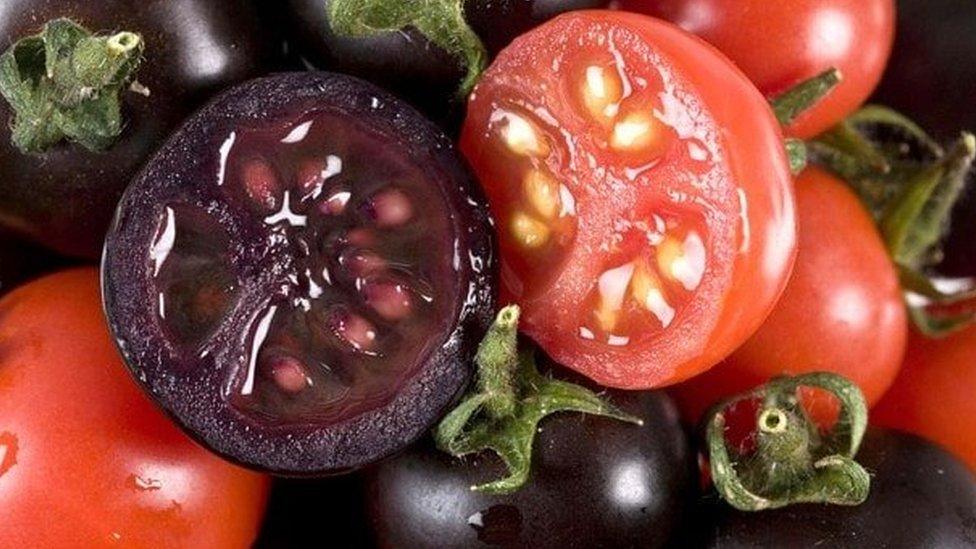Would you like to try super-vitamin, purple tomatoes?
- Published
- comments

You might like a tomato or two but would you fancy a one like this on your pizza or in your salad?
Scientists have changed the genetic makeup of tomatoes so they can provide as much vitamin D as eggs or tuna.
Vitamin D is really important for for keeping bones, teeth and muscles healthy, and can also be absorbed by our bodies from sunlight.
In the UK there is only enough sunlight to achieve this between April and September, meaning we have to rely on food sources or dietary supplements, and it's thought that 13-19% of the UK population don't get enough of the vitamin.
The new tomato plants were created by researchers making tiny changes to an existing tomato gene.
They took the enzyme found in tomato plants that normally converts the provitamin D3 into cholesterol, and stopped this process from happening which meant the provitamin stayed in the tomatoes' fruits and leaves.
They calculated that the amount of provitamin D3 in one tomato fruit - if converted to vitamin D3 - would be equivalent to levels present in two medium-sized eggs or 28 grams of tuna.

To convert this into active vitamin D3, the fruit would still need to be exposed to UVB light, or they could potentially be grown outdoors.
Outdoor field trials of the tomatoes are expected to begin in the UK next month.
There has been strict regulation in the past when it comes to genetically modified organisms (GMOs), which were previously governed by EU regulations.
But scientists hope these gene-edited plants will be treated differently following Brexit, with a bill already having been put before the UK government asking them to consider changing the law.

Often people take Vitamin D capsules if they aren't able to get enough Vitamin D from food or sunlight
As the tomato plants do not contain genes from other organisms they do not have to be considered GMOs, and so could be allowed under the proposed genetic technology (precision breeding) bill.
The environment secretary has predicted that this will be passed into law this year, which could mean the first gene-edited foods to be available by 2023.
Co-author of the study, Professor Cathie Martin said the research showed the potential for gene editing and could generate similar alterations in any elite tomato variety, as well as other vegetables as well!
"[The technique] could also probably work well in other ....food crops such as peppers, chillies, potatoes and aubergines," she added.
She is part of the John Innes Centre, who supervised the study, which was published in the journal Nature Plants.

Would you like to try the purple variety?
She also explained that some of the research the team has done has given the tomatoes a different appearance to the one's you might be familiar with - they're purple!
She said: "Plants don't normally produce provitamin D, which is what we've done.
"Those are genetically modified organisms and there we introduced a couple of genes … pigments in plants that are also supposed to have health benefits, a bit like super fruits, like blackberries and cranberries - the same compounds as in those."
The purple tomato are currently awaiting approval but could soon go on sale in the US later this year.
- Published9 May 2022

- Published1 September 2017

- Published29 April 2021

